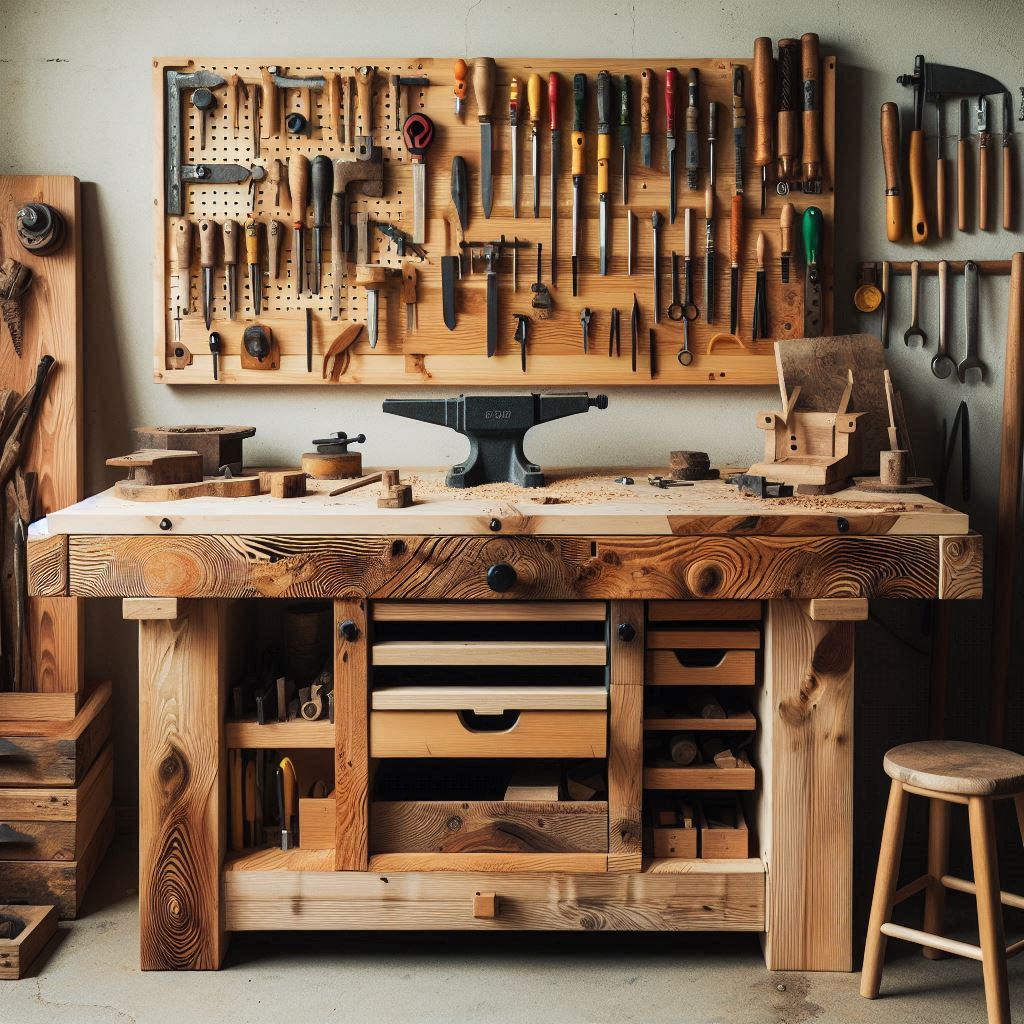
A custom-made workbench is an essential piece of equipment for any serious DIY enthusiast, woodworker, or hobbyist. Unlike mass-produced options, a custom workbench is designed to meet your specific needs, offering the perfect balance of durability, functionality, and convenience.
Whether you’re looking for a compact bench for a small garage or a large, multi-functional workstation, building a custom workbench allows you to tailor every aspect to your exact requirements.
In this article, we’ll guide you through the process of designing and building your own custom-made workbench, from planning and material selection to assembly and finishing touches.
Custom Made WorkBench

Planning Your Custom Workbench
1. Assess Your Needs
Purpose of the Workbench
Consider what tasks you’ll be performing on your workbench. Whether you need a sturdy surface for heavy-duty woodworking, a bench with integrated storage for tools, or a space-saving design for a small workshop, defining the primary use of your workbench will guide your design decisions.
Available Space
Measure the area where you plan to place the workbench. Ensure you have enough space for both the workbench and room to move around comfortably. If space is tight, consider a foldable or mobile design.
2. Design and Features
Size and Dimensions
Determine the ideal size for your workbench. The standard height for a workbench is around 34 to 36 inches, but this can be adjusted based on your height and the type of work you’ll be doing. The width and length will depend on your available space and specific needs.
Work Surface
Choose a material for the work surface that suits your work. Common options include hardwood, plywood, or MDF (Medium-Density Fiberboard). A thick, solid top will provide stability and durability.
Storage Options
Incorporate storage solutions like drawers, shelves, or pegboards into your workbench design. This helps keep tools and materials organized and within easy reach.
Mobility
If you need to move your workbench around the workshop or garage, consider adding heavy-duty casters. Lockable wheels ensure stability when the workbench is in use.
Selecting Materials
1. Work Surface Materials
Hardwood
Hardwood is a durable, long-lasting option for your workbench surface. Maple, oak, and birch are popular choices due to their strength and resistance to wear. However, hardwood can be more expensive than other options.
Plywood
Plywood offers a cost-effective alternative to hardwood. It’s sturdy enough for most DIY tasks and can be easily replaced if damaged. For added durability, consider using a thick, high-grade plywood.
MDF
MDF is smooth, flat, and easy to work with, making it a good choice for a workbench surface. However, it’s not as durable as hardwood and may require additional protection, like a hardboard or laminate top.
2. Frame Materials
Construction Lumber
Standard construction lumber, like 2x4s or 4x4s, is a budget-friendly option for building the workbench frame. It’s readily available and strong enough to support heavy work.
Steel or Metal
For a more industrial design, consider using steel or metal for the frame. This provides exceptional strength and durability, especially for heavy-duty tasks.
3. Fasteners and Hardware
Screws and Bolts
Use heavy-duty screws and bolts to assemble your workbench. For added strength, consider using lag bolts to secure the frame.
Clamps and Vises
Incorporate clamps or a built-in vise into your workbench design. These tools are essential for holding materials steady while you work.
Building Your Custom Workbench
1. Cutting and Assembling the Frame
Cut the Lumber
Measure and cut the lumber according to your design specifications. Ensure all pieces are cut to the correct length and angle to ensure a stable and level frame.
Assemble the Frame
Begin by assembling the legs and base of the workbench. Use screws or bolts to secure the pieces together, ensuring the frame is square and level.
2. Installing the Work Surface
Attach the Surface
Place the work surface on top of the assembled frame. Secure it using screws or bolts, ensuring the surface is flush and stable. If using plywood or MDF, consider doubling up the material for added thickness.
Finish the Edges
Sand the edges of the work surface to smooth out any rough spots. You can also add edge banding or a hardwood trim for a finished look.
3. Adding Storage and Accessories
Install Drawers or Shelves
If your design includes storage, install drawers, shelves, or pegboards at this stage. Ensure they are securely attached and can support the weight of your tools and materials.
Add Clamps and Vises
Attach any clamps or vises to the workbench surface. Position them in areas where they will be most useful, such as along the edges or corners of the bench.
4. Finishing Touches
Sand and Finish
Sand the entire workbench to remove any rough spots or splinters. Apply a finish, such as varnish or polyurethane, to protect the wood and give it a polished look.
Test Stability
Before using your new workbench, test its stability by placing weight on the surface and checking for any wobbling or movement. Make adjustments as needed to ensure a sturdy and secure workstation.
Maintaining Your Custom Workbench
1. Regular Cleaning
Wipe Down After Use: Keep your workbench clean by wiping it down after each use. Remove sawdust, debris, and any spills to prevent damage to the surface.
2. Periodic Inspections
Check for Wear and Tear: Periodically inspect your workbench for signs of wear, such as loose screws, cracks, or surface damage. Address any issues promptly to maintain the workbench’s durability.
3. Surface Protection
Use Mats or Covers: Protect your workbench surface by using mats or covers when working with harsh chemicals or heavy materials. This helps prevent scratches and stains.
What Are The Benefits Of Custom Workbench
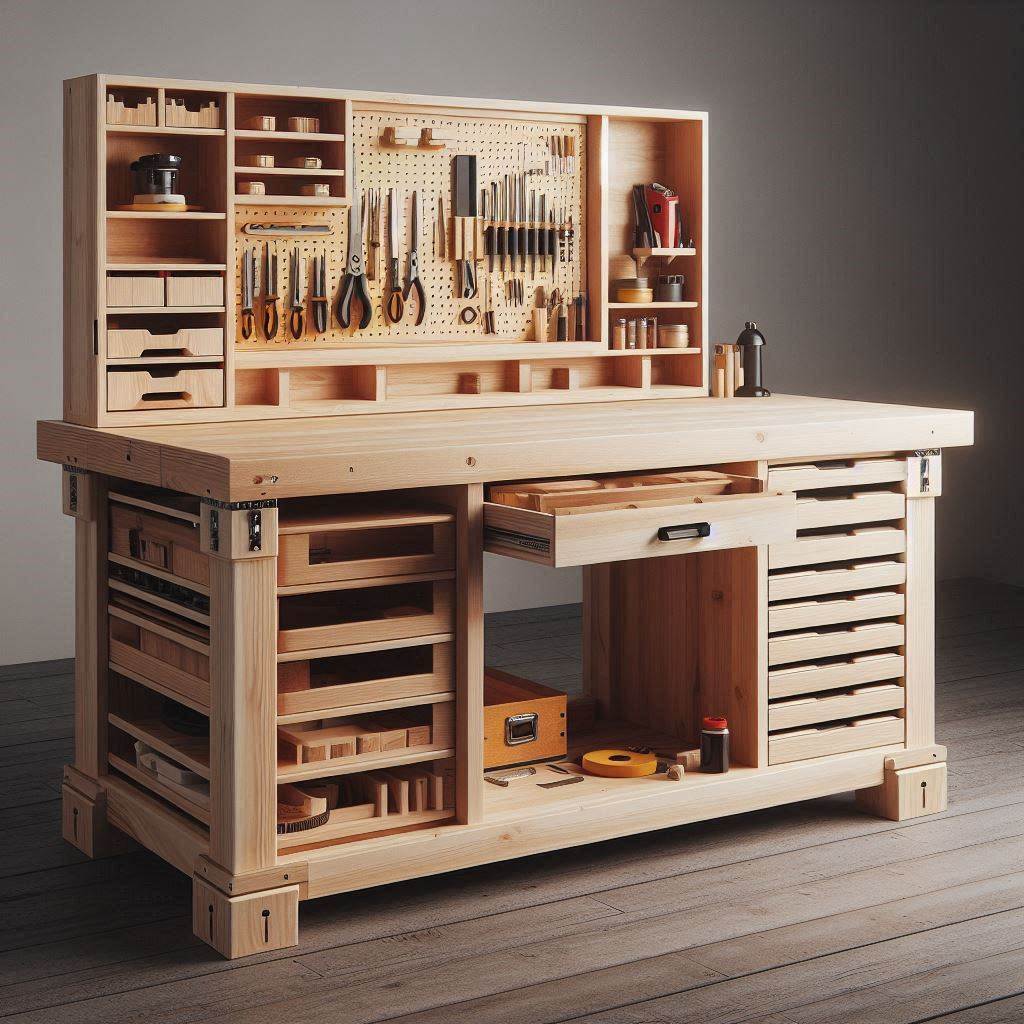
Benefits of a Custom Workbench
A custom workbench offers numerous advantages over pre-made or store-bought options, making it a valuable addition to any workshop or garage. Here are some key benefits:
1. Personalized Design
Tailored to Your Needs
A custom workbench is designed specifically for your tasks and workflow. Whether you need extra storage, specific dimensions, or built-in features like clamps or a vise, you can create a bench that perfectly suits your work style.
Optimal Size and Fit
You can build the workbench to fit the exact space you have available, ensuring it integrates seamlessly into your workshop or garage. This is especially beneficial for small spaces or irregularly shaped areas.
2. Enhanced Functionality
Custom Storage Solutions
Incorporating drawers, shelves, or cabinets into your workbench design allows you to keep tools and materials organized and within easy reach. This maximizes efficiency and reduces the time spent searching for items.
Specialized Features
You can include features that cater specifically to your projects, such as a reinforced surface for heavy-duty work, integrated lighting, or adjustable height. These customizations improve your overall productivity and comfort.
3. Durability and Quality
Choice of Materials
When building a custom workbench, you have control over the quality of materials used. You can select sturdy, durable materials that will withstand heavy use and last for years, unlike some pre-made options that may be less durable.
Built to Last
By constructing your workbench with high-quality materials and robust construction techniques, you ensure it meets your durability requirements. A well-built custom workbench can handle the rigors of daily use without wearing out.
4. Cost Efficiency
Budget Control
Building your own workbench allows you to control costs by choosing materials and features that fit your budget. You can invest in quality where it matters most and save on less critical areas, potentially making it more affordable than a high-end pre-made bench.
Long-Term Savings
A custom workbench that’s built to last can save you money in the long run. You won’t need to replace or repair it as frequently as cheaper, mass-produced options.
5. Satisfaction and Pride
Sense of Accomplishment
Building your own workbench is a rewarding project that gives you a sense of pride and accomplishment. Every time you use it, you’ll appreciate the effort and craftsmanship that went into creating it.
Customization Experience
The process of designing and building a custom workbench allows you to learn and develop new skills. It’s an opportunity to experiment with woodworking, design, and construction, which can be both educational and enjoyable.
6. Flexibility and Adaptability
Future Modifications
A custom workbench can be easily modified or expanded in the future as your needs change. You can add more storage, upgrade the work surface, or integrate new tools, making it a versatile and adaptable workspace.
Unique Solutions
If you have specific requirements that off-the-shelf workbenches don’t meet, a custom workbench offers unique solutions. Whether it’s a compact design for a small space or a multi-functional bench for various tasks, customization provides the flexibility to meet your exact needs.
Overall, a custom workbench offers a combination of personalization, functionality, durability, and cost efficiency that’s hard to match with store-bought options. It’s an investment in your workspace that pays off in both practicality and satisfaction.
What Is The Difference Between WorkBench And Customizing?
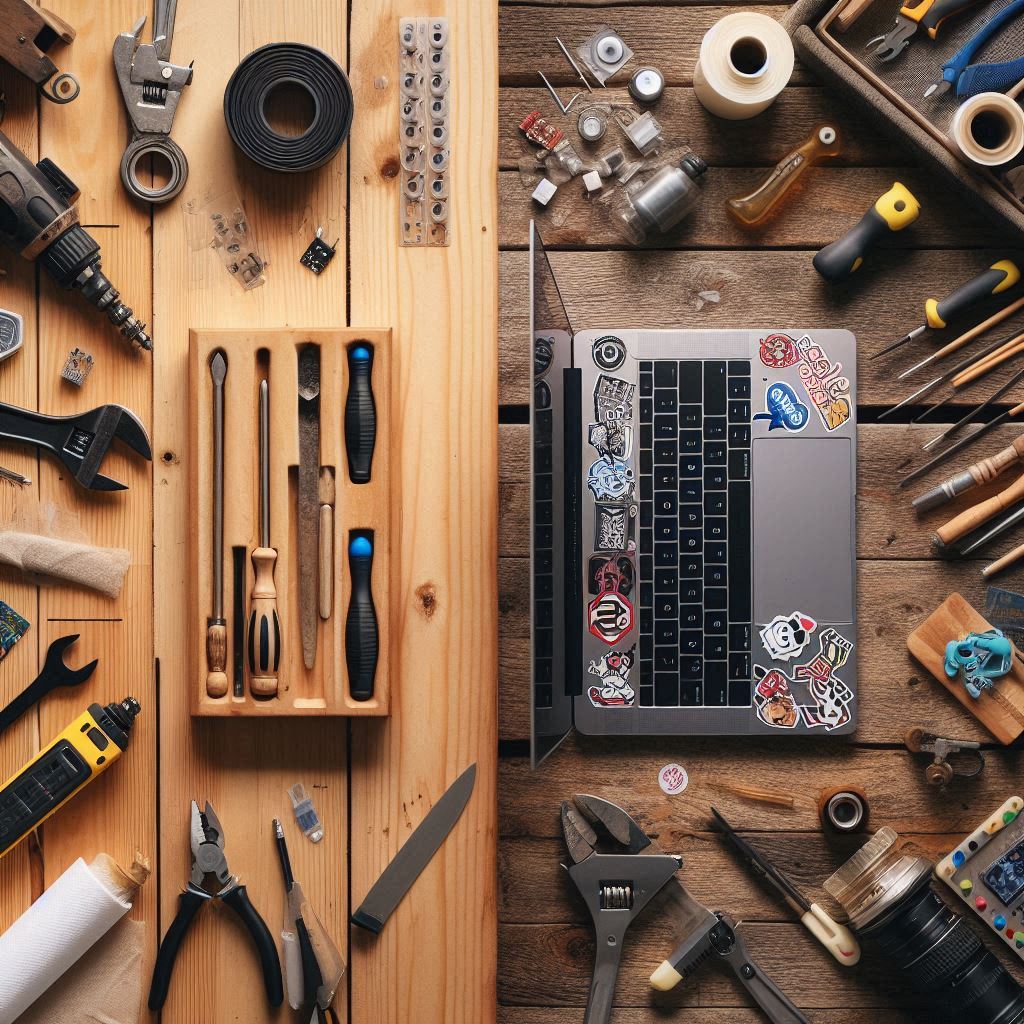
Workbench and customizing are related concepts, but they refer to different aspects of creating a workspace.
1. Workbench
Definition
A workbench is a sturdy table or surface designed for manual work such as woodworking, metalworking, or other DIY projects. It typically includes a flat work surface and may have built-in features like a vise, storage drawers, or shelves.
Purpose
- Work Surface: Provides a stable area for various tasks, such as cutting, assembling, and finishing projects.
- Tool Organization: Often includes storage options for keeping tools and materials organized and within easy reach.
- Support for Projects: Offers a solid foundation for heavy-duty tasks, ensuring accuracy and stability during work.
Types
- Pre-Made Workbench: Available in stores, these come in standard sizes and designs and are ready to use upon purchase.
- Custom-Made Workbench: Built to specific dimensions and requirements, tailored to the user’s needs.
2. Customizing
Definition
Customizing refers to the process of modifying or personalizing an object, design, or space to better fit specific needs, preferences, or functionality. In the context of a workbench, customizing involves altering the design, materials, or features to suit individual requirements.
Purpose
- Personalization: Allows you to tailor the workbench to your specific tasks, whether you need additional storage, a particular work surface material, or unique features.
- Functionality Enhancement: By customizing, you can improve the functionality of a workbench, adding elements like adjustable height, built-in lighting, or specific tool holders.
- Space Optimization: Customizing can help make the most of your available space, ensuring the workbench fits perfectly and integrates well into your workshop or garage.
Examples of Customizing
- Adding Storage: Integrating custom drawers, shelves, or cabinets into the workbench design.
- Material Choices: Selecting specific materials for the work surface or frame based on the intended use.
- Special Features: Including elements like clamps, vises, or power outlets directly into the workbench.
Key Differences
- Workbench: Refers to the actual piece of equipment used for manual work. It’s a physical object that provides a work surface and may include basic storage or tool-holding features.
- Customizing: Refers to the process of altering or personalizing a workbench (or other objects) to better meet your needs. It’s an action or series of modifications rather than a standalone item.
In summary, a workbench is what you use for your projects, while customizing is what you do to a workbench (or other items) to make it better suited to your specific needs.
Durability & Construction Quality Of Custom WorkBench
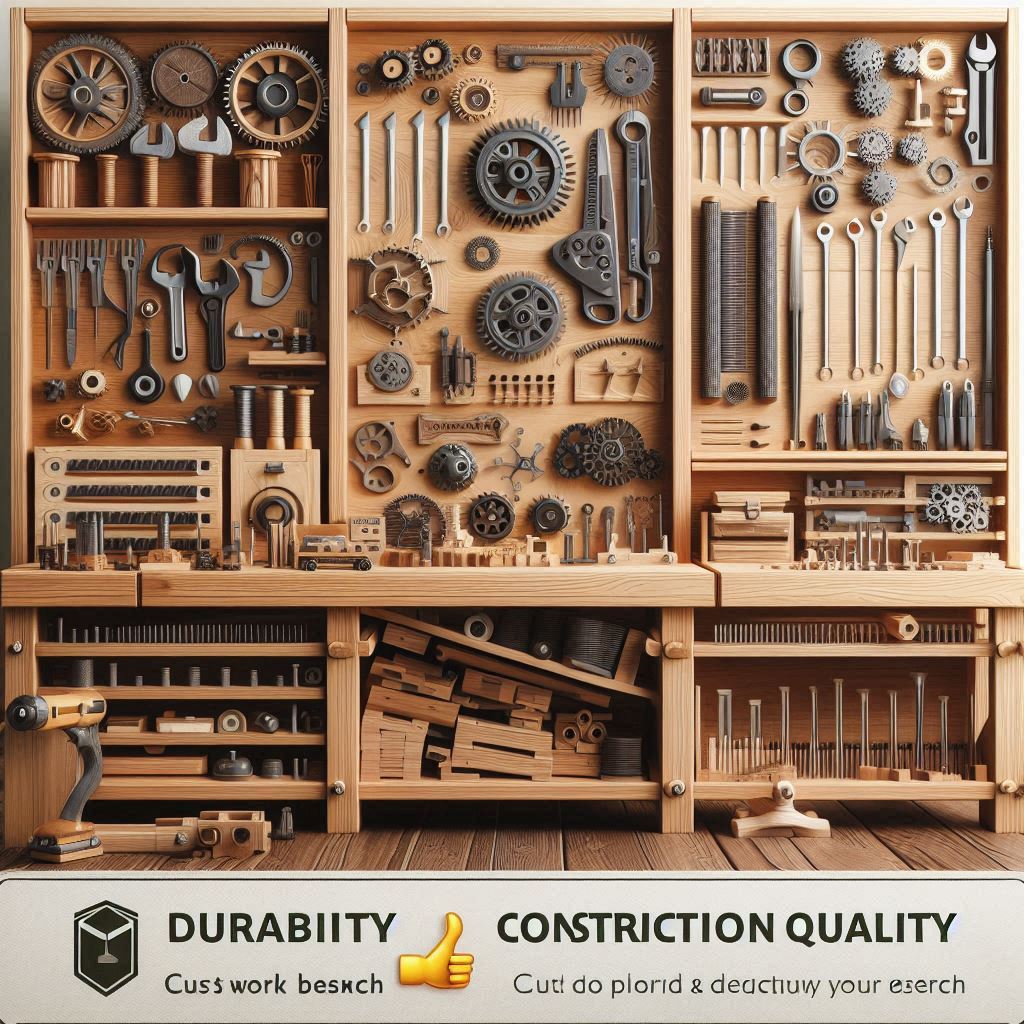
Creating a custom workbench involves careful consideration of both durability and construction quality. These factors are crucial in ensuring that the workbench stands up to heavy use and remains functional over time.
Durability
Material Selection
Work Surface
- Hardwood: Hardwood surfaces like maple or oak are known for their strength and resistance to wear, making them ideal for heavy-duty tasks.
- Plywood: High-grade plywood can be a cost-effective option. Reinforcing it with a hardboard or laminate top can improve its durability.
- Metal or Steel: For heavy industrial use, metal or steel surfaces offer exceptional durability, resisting impact, heat, and chemicals.
Frame and Legs
- Construction Lumber: Standard lumber (2x4s, 4x4s) provides a robust frame. Pressure-treated wood adds resistance to moisture and pests.
- Metal Frames: Steel or aluminum frames offer superior strength and longevity, suitable for high-capacity and industrial applications.
Construction Techniques
Joinery and Fastening
- Strong Joints: Techniques like mortise and tenon or dovetail joints improve stability. Reinforcing with screws or bolts adds additional strength.
- Heavy-Duty Fasteners: Using high-quality screws and bolts ensures the workbench can handle significant loads without failing.
Surface Treatment
- Protective Finishes: Applying finishes like polyurethane or epoxy protects against moisture, stains, and scratches, extending the workbench’s life.
- Edge Reinforcement: Adding trim or metal edging can prevent chipping and prolong the work surface’s durability.
Weight Capacity
- Load-Bearing Design: Ensure that the frame and legs are adequately braced to support heavy tools and materials, preventing warping or collapse.
Construction Quality
Precision and Craftsmanship
Accurate Measurements
- Square and Level Construction: Precise measurements and cuts are essential for a level and stable workbench.
- Alignment and Symmetry: Proper alignment of components like legs and shelves ensures functionality and visual appeal.
Smooth Finishing
- Sanding: Smooth all surfaces, edges, and joints to prevent splinters and ensure comfort.
- Finishing Touches: Attention to detail in joins, flush surfaces, and well-fitted storage options reflects high-quality construction.
Custom Features
Integrated Storage
- Durable Drawers and Shelves: Use strong materials and quality hardware for drawers and shelves to ensure they withstand frequent use.
- Secure Mounting: Ensure that additional features like vises and tool racks are securely mounted to handle stress without loosening.
Modular and Flexible Design
- Adjustable Components: If the workbench includes adjustable parts, such as height-adjustable legs, ensure they are designed for stability and ease of use.
Price & Value of Custom Workbench
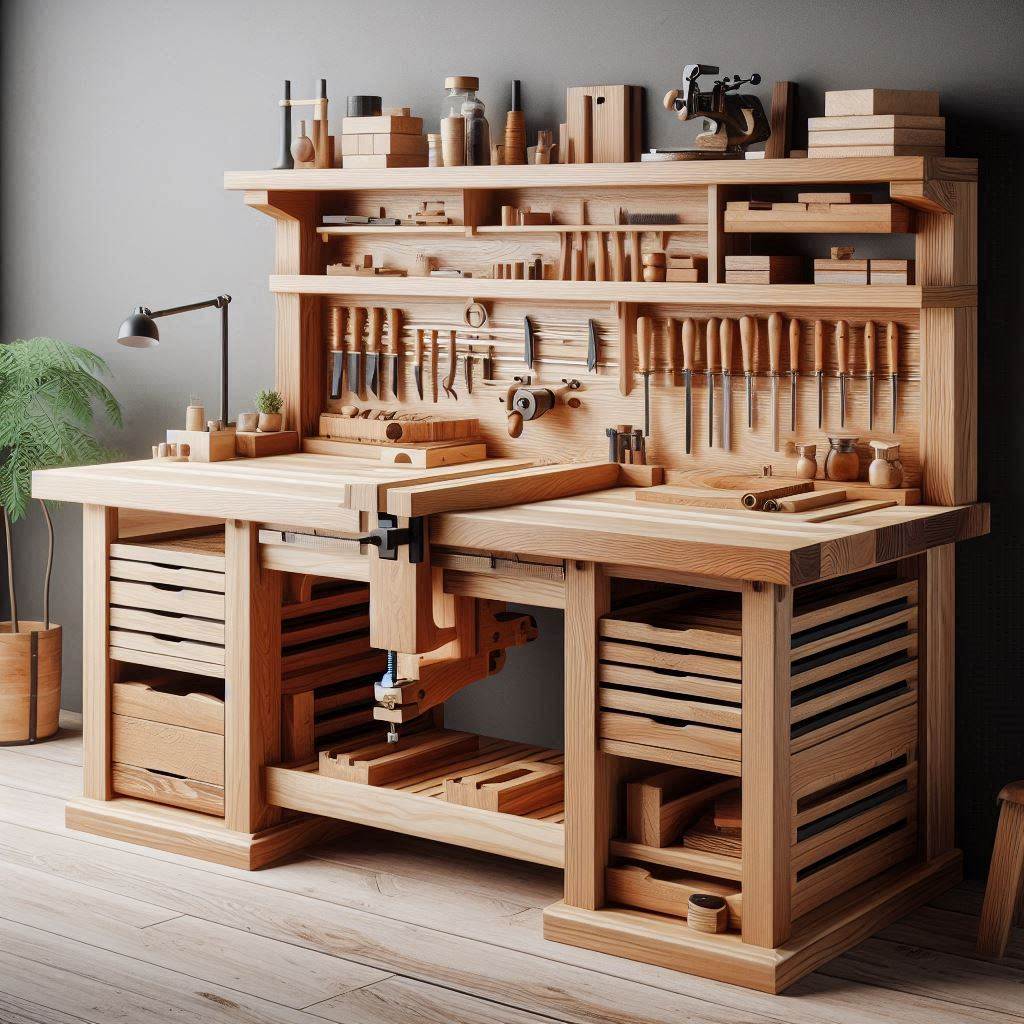
When considering a custom workbench, it’s essential to evaluate both the price and the value it offers. Custom workbenches can range significantly in cost depending on materials, size, and features, but understanding the value they provide can help you make an informed decision.
Price Factors
Material Costs
Work Surface
- Hardwood: High-quality hardwood surfaces can be expensive but offer excellent durability and aesthetics. Costs vary based on the type of wood and thickness.
- Plywood: More affordable than hardwood, plywood offers good durability when properly reinforced. Costs depend on the grade and thickness of the plywood.
- Metal or Steel: Metal surfaces can be pricey, especially if using high-grade steel or custom fabrication. However, they offer superior strength and durability.
Frame and Legs
- Construction Lumber: Standard lumber is budget-friendly and widely available. Costs are influenced by the type and amount of lumber used.
- Metal Frames: Steel or aluminum frames can be more costly but provide enhanced strength and longevity. Fabrication and finishing add to the expense.
Construction Techniques
Joinery and Fastening
- High-Quality Fasteners: Using durable screws, bolts, and other hardware adds to the overall cost but ensures a robust build.
- Joinery Methods: Advanced joinery techniques or professional craftsmanship can increase the price, but they improve durability and appearance.
Custom Features
Storage Solutions
- Drawers and Shelves: Adding custom storage solutions increases the cost but enhances functionality and organization.
- Specialized Features: Features like integrated lighting, clamps, or power outlets add to the cost but provide additional convenience and efficiency.
Value Considerations
Personalization and Functionality
Tailored Design
- Fit for Purpose: A custom workbench is designed to meet your specific needs, offering features and dimensions that standard models may lack. This personalization adds significant value to the workbench.
Enhanced Efficiency
- Optimized Workflow: Custom features and layout improvements enhance your workflow, making tasks easier and more efficient. This can increase productivity and reduce time spent searching for tools or materials.
Durability and Longevity
High-Quality Materials
- Long-Term Investment: Investing in durable materials and construction methods means the workbench will last longer, providing better value over time compared to cheaper, less robust options.
Reduced Maintenance
- Lower Maintenance Costs: A well-built custom workbench typically requires less maintenance and repair, saving money and effort in the long run.
Cost vs. Benefit
Initial Expense vs. Long-Term Gains
- Higher Initial Cost: Custom workbenches can be more expensive upfront, but the benefits of tailored functionality, enhanced durability, and improved workflow often outweigh the initial cost.
- Value for Money: Evaluate the cost in relation to the features and benefits provided. A custom workbench that meets your exact needs and lasts for years is often a worthwhile investment.
Difference Between a Workbench and Customizing
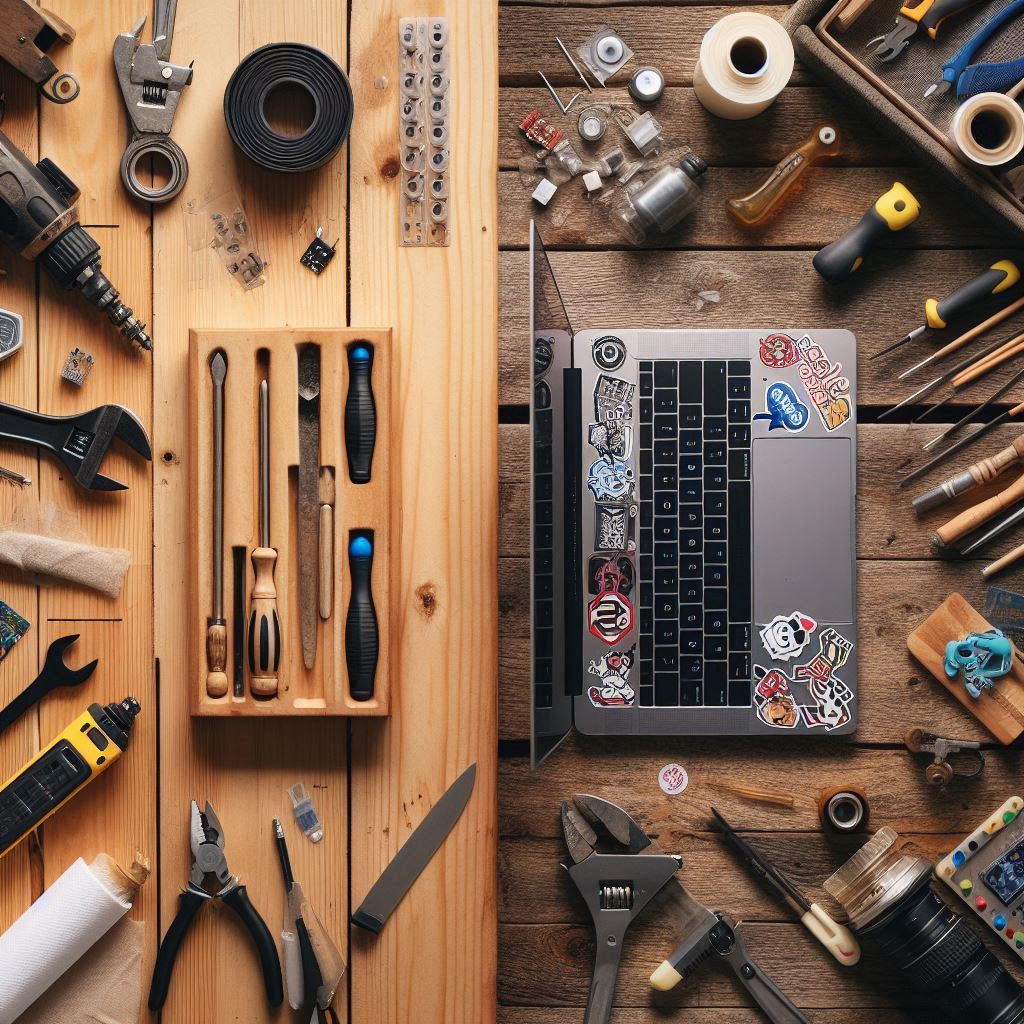
Workbench and customizing are related concepts, but they refer to different aspects of creating a workspace.
1. Workbench
Definition
A workbench is a sturdy table or surface designed for manual work such as woodworking, metalworking, or other DIY projects. It typically includes a flat work surface and may have built-in features like a vise, storage drawers, or shelves.
Purpose
- Work Surface: Provides a stable area for various tasks, such as cutting, assembling, and finishing projects.
- Tool Organization: Often includes storage options for keeping tools and materials organized and within easy reach.
- Support for Projects: Offers a solid foundation for heavy-duty tasks, ensuring accuracy and stability during work.
Types
- Pre-Made Workbench: Available in stores, these come in standard sizes and designs and are ready to use upon purchase.
- Custom-Made Workbench: Built to specific dimensions and requirements, tailored to the user’s needs.
2. Customizing
Definition
Customizing refers to the process of modifying or personalizing an object, design, or space to better fit specific needs, preferences, or functionality. In the context of a workbench, customizing involves altering the design, materials, or features to suit individual requirements.
Purpose
- Personalization: Allows you to tailor the workbench to your specific tasks, whether you need additional storage, a particular work surface material, or unique features.
- Functionality Enhancement: By customizing, you can improve the functionality of a workbench, adding elements like adjustable height, built-in lighting, or specific tool holders.
- Space Optimization: Customizing can help make the most of your available space, ensuring the workbench fits perfectly and integrates well into your workshop or garage.
Examples of Customizing
- Adding Storage: Integrating custom drawers, shelves, or cabinets into the workbench design.
- Material Choices: Selecting specific materials for the work surface or frame based on the intended use.
- Special Features: Including elements like clamps, vises, or power outlets directly into the workbench.
Key Differences
- Workbench: Refers to the actual piece of equipment used for manual work. It’s a physical object that provides a work surface and may include basic storage or tool-holding features.
- Customizing: Refers to the process of altering or personalizing a workbench (or other objects) to better meet your needs. It’s an action or series of modifications rather than a standalone item.
In summary, a workbench is what you use for your projects, while customizing is what you do to a workbench (or other items) to make it better suited to your specific needs.
Durability & Construction Quality of a Custom Workbench
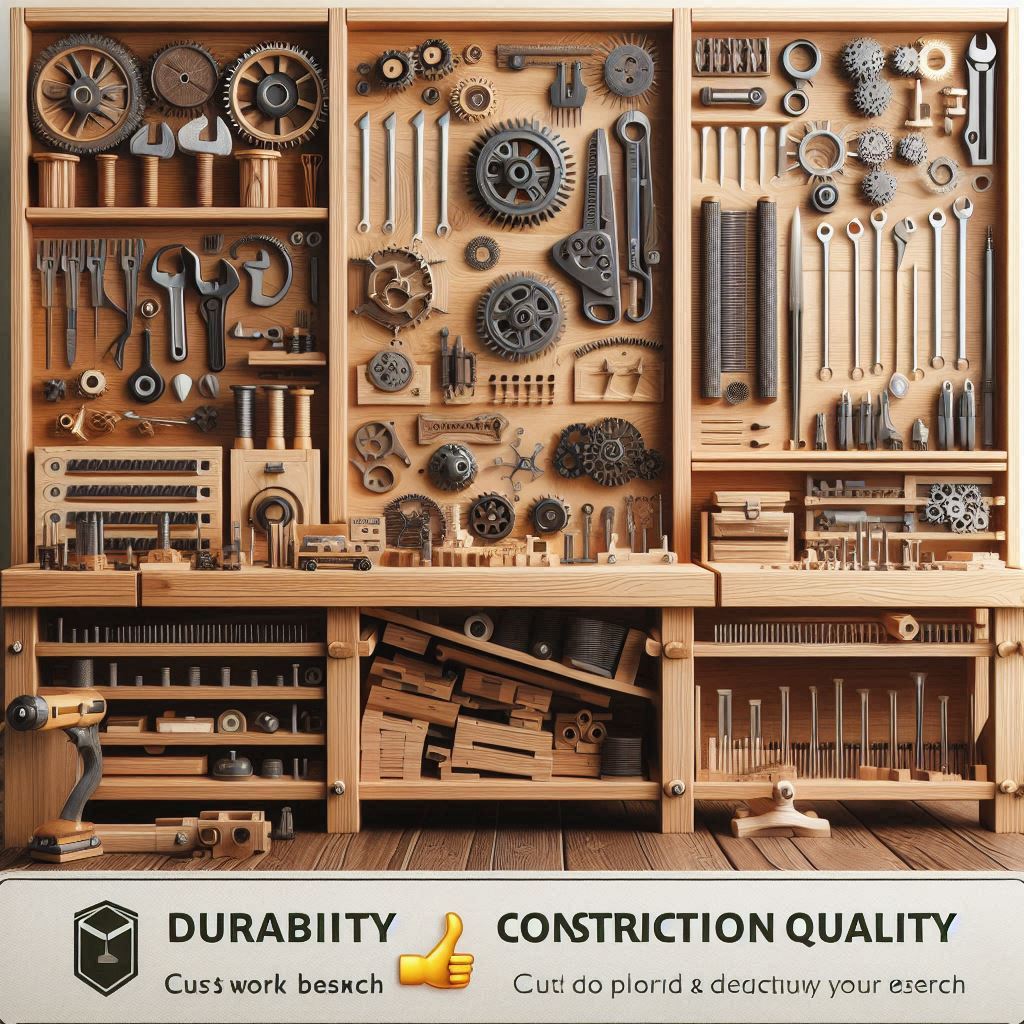
The durability and construction quality of a custom workbench are critical factors that determine its longevity, functionality, and ability to withstand the demands of various tasks. When you build a custom workbench, you have control over the materials and construction methods, allowing you to create a piece that is both robust and tailored to your specific needs.
1. Durability
Material Selection
Work Surface
- Hardwood: A popular choice for its strength and resistance to wear, hardwood surfaces like maple, oak, or birch can endure heavy use and resist damage from tools and materials.
- Plywood: While more affordable, high-grade plywood with a thick veneer can also offer good durability, especially if it’s reinforced or protected with a hardboard or laminate top.
- Metal or Steel: For industrial or heavy-duty use, metal or steel work surfaces provide exceptional durability and resistance to impact, heat, and chemicals.
Frame and Legs
- Construction Lumber: Commonly used for the frame, standard 2×4 or 4×4 lumber provides a strong, cost-effective foundation. Pressure-treated wood can also enhance durability by resisting moisture and pests.
- Metal Frames: Using steel or aluminum for the frame increases the workbench’s load-bearing capacity and overall lifespan, making it suitable for heavier projects or industrial environments.
Construction Techniques
Joinery and Fastening
- Strong Joints: Using traditional joinery methods, like mortise and tenon or dovetail joints, enhances the workbench’s stability and longevity. Reinforced joints with screws or bolts can also add strength.
- Heavy-Duty Fasteners: High-quality screws, bolts, and lag screws ensure the workbench stays together under stress. Choosing the right fasteners for the material and weight load is crucial for durability.
Surface Treatment
- Protective Finishes: Applying a finish, such as polyurethane, varnish, or epoxy, protects the work surface from moisture, stains, and scratches. Regular maintenance and refinishing can extend the life of the workbench.
- Edge Reinforcement: Adding a hardwood trim or metal edging to the work surface can prevent chipping and damage over time, especially on frequently used edges.
Weight Capacity
- Load-Bearing Design: Ensuring the frame and legs are properly braced and supported will allow the workbench to hold heavy tools and materials without warping or collapsing. For high-capacity needs, additional cross-bracing or a thicker frame may be necessary.
2. Construction Quality
Precision and Craftsmanship
Accurate Measurements
- Square and Level Construction: Precise measurements and cuts ensure the workbench is square, level, and stable. Any deviation can affect the workbench’s performance and longevity.
- Alignment and Symmetry: Proper alignment of components, such as legs, shelves, and drawers, contributes to the overall quality and functionality of the workbench.
Smooth Finishing
- Sanding: Thorough sanding of all surfaces, edges, and joints ensures a smooth, splinter-free workbench that’s safe and comfortable to use.
- Finishing Touches: Attention to detail, such as clean joins, flush surfaces, and well-fitted storage options, reflects high construction quality and enhances the workbench’s aesthetic appeal.
Custom Features
Integrated Storage
- Durable Drawers and Shelves: Custom storage solutions should be constructed with strong materials and smooth-operating hardware, such as ball-bearing drawer slides, to ensure they hold up under repeated use.
- Secure Mounting: Any added features, like vises, clamps, or tool racks, should be securely mounted to handle the stresses of frequent use without loosening or breaking.
Modular and Flexible Design
- Adjustable Components: If your custom workbench includes adjustable elements, like height-adjustable legs or removable shelves, these should be designed for easy adjustment while maintaining stability and strength.
Final Thoughts
The durability and
4o
can u use h2 h3 h4 format its easierChatGPTMemory updated
Durability & Construction Quality of a Custom Workbench
Creating a custom workbench involves careful consideration of both durability and construction quality. These factors are crucial in ensuring that the workbench stands up to heavy use and remains functional over time.
Durability
Material Selection
Work Surface
- Hardwood: Hardwood surfaces like maple or oak are known for their strength and resistance to wear, making them ideal for heavy-duty tasks.
- Plywood: High-grade plywood can be a cost-effective option. Reinforcing it with a hardboard or laminate top can improve its durability.
- Metal or Steel: For heavy industrial use, metal or steel surfaces offer exceptional durability, resisting impact, heat, and chemicals.
Frame and Legs
- Construction Lumber: Standard lumber (2x4s, 4x4s) provides a robust frame. Pressure-treated wood adds resistance to moisture and pests.
- Metal Frames: Steel or aluminum frames offer superior strength and longevity, suitable for high-capacity and industrial applications.
Construction Techniques
Joinery and Fastening
- Strong Joints: Techniques like mortise and tenon or dovetail joints improve stability. Reinforcing with screws or bolts adds additional strength.
- Heavy-Duty Fasteners: Using high-quality screws and bolts ensures the workbench can handle significant loads without failing.
Surface Treatment
- Protective Finishes: Applying finishes like polyurethane or epoxy protects against moisture, stains, and scratches, extending the workbench’s life.
- Edge Reinforcement: Adding trim or metal edging can prevent chipping and prolong the work surface’s durability.
Weight Capacity
- Load-Bearing Design: Ensure that the frame and legs are adequately braced to support heavy tools and materials, preventing warping or collapse.
Construction Quality
Precision and Craftsmanship
Accurate Measurements
- Square and Level Construction: Precise measurements and cuts are essential for a level and stable workbench.
- Alignment and Symmetry: Proper alignment of components like legs and shelves ensures functionality and visual appeal.
Smooth Finishing
- Sanding: Smooth all surfaces, edges, and joints to prevent splinters and ensure comfort.
- Finishing Touches: Attention to detail in joins, flush surfaces, and well-fitted storage options reflects high-quality construction.
Custom Features
Integrated Storage
- Durable Drawers and Shelves: Use strong materials and quality hardware for drawers and shelves to ensure they withstand frequent use.
- Secure Mounting: Ensure that additional features like vises and tool racks are securely mounted to handle stress without loosening.
Modular and Flexible Design
- Adjustable Components: If the workbench includes adjustable parts, such as height-adjustable legs, ensure they are designed for stability and ease of use.
Conclusion
A custom-made workbench is a significant investment that can greatly enhance your workspace by providing a tailored solution to your specific needs. While the price can vary depending on materials, design, and features, the value it offers in terms of personalized functionality, durability, and efficiency often outweighs the initial cost.
By investing in a custom workbench, you’re not just purchasing a piece of equipment; you’re creating a workspace that supports your projects, enhances your productivity, and lasts for years. Careful consideration of your requirements and budget will ensure that your custom workbench delivers exceptional performance and value.
FAQs on Custom-Made Workbenches
Q1: How much does a custom-made workbench typically cost?
A1: The cost of a custom-made workbench varies widely depending on factors such as materials, size, design, and features. On average, prices can range from a few hundred to several thousand dollars. For a basic model with standard materials and features, you might expect to pay between $500 and $1,500. More complex designs with high-quality materials and advanced features can exceed $2,000. It’s essential to get a detailed quote based on your specific requirements to understand the total cost.
Q2: What are the key benefits of investing in a custom-made workbench?
A2: The primary benefits of a custom-made workbench include personalized design, tailored functionality, and enhanced durability. A custom workbench is designed to meet your specific needs, optimizing your workspace for efficiency and productivity. It also allows you to choose high-quality materials and construction methods, ensuring a robust and long-lasting workspace. Additionally, custom features such as integrated storage or adjustable components can improve your overall work experience.
Q3: How do I determine the right size and design for my custom workbench?
A3: To determine the right size and design, assess your workspace dimensions and the type of work you’ll be doing. Measure the available space and consider how much room you need for tools, materials, and movement. Think about the features you require, such as storage options, work surface dimensions, and any special tools or equipment you’ll be using. Consulting with a professional or using design software can help you visualize and plan your custom workbench effectively.
Q4: What materials are best for a custom workbench?
A4: The best materials for a custom workbench depend on your needs and budget. Common options include hardwoods like maple or oak for durability and aesthetics, plywood for a more affordable solution, and metal or steel for heavy-duty applications. For the frame, construction lumber is cost-effective and strong, while metal frames offer additional strength and longevity. Choose materials based on the type of work you’ll be doing and the level of wear and tear you expect.
Q5: How long does it take to build a custom workbench?
A5: The time required to build a custom workbench varies based on its complexity and the builder’s experience. A basic custom workbench may take a few days to complete, while more elaborate designs with advanced features and high-quality finishes might take several weeks. Factors like material availability, construction techniques, and finishing work can affect the overall timeline. It’s best to discuss the expected timeline with your builder to get a more accurate estimate.
